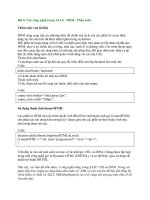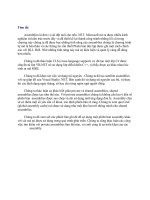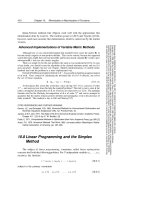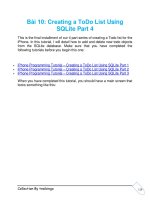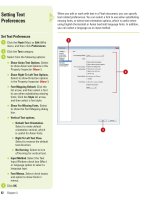KEY CONCEPTS & TECHNIQUES IN GIS Part 9 pdf
Bạn đang xem bản rút gọn của tài liệu. Xem và tải ngay bản đầy đủ của tài liệu tại đây (97.85 KB, 13 trang )
92 KEY CONCEPTS AND TECHNIQUES IN GIS
Object view
Represents the features as discrete objects with well-define boundaries in an empty
space
Ontology
Formal specification of the meaning of a datum
Overlay
Quintessential GIS operation that determines spatial coincidences
PDF
Portable document format – an open file format for the description of device-
independent documents
Pedologist
One who studies soil science
Precision
The amount of detail that can be discerned in geographic information
Projection
See Map projection
Raster
Spatial organization of data similar to an array or a spreadsheet; space is com-
pletely filled by the cells that make up the raster
Regional science
Academic discipline at the intersection of economics and geography that devel-
oped its own set of spatial analysis techniques
Remote sensing
The technique (and science behind) gathering information from objects without
touching them
Scanning
An automated form of digitizing that results in raster data
Semantics
The meaning of a datum
Shape measures
Set of statistical measures to describe spatial configurations; originally devel-
oped in landscape ecology
Spatial reference
Descriptor for a location on Earth
SQL
Structured query language – a standard (with many variations) way of querying a
database
Albrecht-3572-Glossary.qxd 7/13/2007 4:19 PM Page 92
SVG
Scalable vector graphics – an XML dialect for the description of vector data
Thiessen polygon
For a point dataset, the area around one point that is closer to this point than
to any other point
TIFF
Tagged image file format – an error-free storage format for raster data
TIN
Triangulated irregular network – a representation of a surface derived from
irregularly spaced sample points
Topology
Branch of mathematics that deals with qualitative spatial relations. Topological rela-
tionships are important for many GIS operations and have been used as a check for
the geometric consistency of a GIS database
UML
Unified modeling language – an ISO standard for the specification of database
schemas
Unix
Family of multi-user operating systems
UTM
Universal Transverse Mercator projection and coordinate system. Originally used
by the US armed forces, it is now common throughout the world for GIS applica-
tions covering larger areas
Vector GIS
GIS that uses points, lines and polygons to represent geographic features
Web 2.0
A set of techniques associated with web technologies that enable users to
develop their own applications
XML
Extensible markup language – a superset of what many know as web description
languages such as HTML. XML is not meant to be read by humans but to facili-
tate automated exchanges between computers
GLOSSARY 93
Albrecht-3572-Glossary.qxd 7/13/2007 4:19 PM Page 93
Albrecht-3572-Glossary.qxd 7/13/2007 4:19 PM Page 94
Alonso, W. (1978). A theory of movements. In Hansen, N.M. (ed.): Human Settlement
Systems: International Perspectives on Structure, Change and Public Policy, pp. 197–211.
Cambridge, MA: Ballinger Publishing.
Batty, M. (2001). Cellular dynamics: modelling urban growth as a spatial epidemic. In Fischer,
M. and Leung, Y. (eds): GeoComputational Modelling: Techniques and Application,
pp. 109–141. Berlin: Springer-Verlag.
Benenson, I., Omer, I. and Hatna, E. (2002). Entity-based modeling of urban residential
dynamics: the case of Yaffo, Tel Aviv. Environment and Planning B: Planning and Design,
29, 491–512.
Bettinger, P. and Sessions, J. (2003). Spatial forest planning: to adopt, or not to adopt?
Journal of Forestry, 101(2), 24.
Bian, L. (2000). Object-oriented representation for modelling objects in an aquatic envi-
ronment. International Journal of Geographic Information Science, 14, 603–623.
Box, P. (2002). Spatial units as agents: making the landscape an equal player in agent-based
simulations. In Gimblett, H.R. (ed.): Integrating Geographic Information Systems and
Agent-based Modeling Techniques for Simulating Social and Ecological Processes, pp.
59–82. New York: Oxford University Press.
Bryant, R. (2005). Assisted GPS: using cellular telephone networks for GPS anywhere. GPS
World, May 2005, 40–46. Online article at www.gpsworld.com/gpsworld/content/print
ContentPopup.jsp?id=163593
Burrough, P.A. (1986). Principles of Geographic Information Systems. Oxford: Oxford
University Press.
Burrough, P.A. and Frank, A.U. (1996). Geographic Objects with Indeterminate Boundaries.
London: Taylor & Francis.
Chrisman, N. (2002). Exploring Geographic Information Systems. New York: Wiley.
CityGML (2005). Exchange and storage of virtual 3D city models. OGC discussion paper,
available online at files/?artifact_id= 16675
Conte, R., Edmonds, B., Moss, S. and Sawyer, K. (2001). Sociology and social theory in agent-
based social simulation: a symposium. Computational and Mathematical Organization
Theory, 7(3), 183–205.
Couclelis, H. (1982). Philosophy in the construction of geographic reality: some thoughts
upon the advent of the ‘qualitative revolution’ in human geography. In Gould, P. and
Olsson, G. (eds): A Search for Common Ground, pp. 105–138. London: Pion.
References
Albrecht-3572-References.qxd 7/13/2007 4:20 PM Page 95
96 KEY CONCEPTS AND TECHNIQUES IN GIS
Couclelis, H. (1992). People manipulate objects (but cultivate fields): beyond the
raster–vector debate in GIS. In Theories and Methods of Spatio-Temporal Reasoning in
Geographic Space, vol. 639. Berlin: York: Springer-Verlag.
Deadman, P. and Gimblett, H.R. (1994). The role of goal-oriented autonomous agents in
modeling people–environment interactions in forest recreation. Mathematical and
Computer Modeling, 20(8), 121–133.
Dean, J.S., Gumerman, G.J., Epstein, J.M., Axtell, R.L., Swedlund, A.C., Parker, M.T. and
McCarroll, S. (2000). Understanding Anasazi cultural change through agent-based
modeling. In Kohler, T.A. and Gumerman, G.J. (eds): Dynamics in Human and Primate
Societies, pp. 179–205. Oxford: Oxford University Press.
ECMA (2006). Universal 3D File Format, 3rd edn. ECMA International and European
Association for Standardizing Information and Communication Systems, Geneva. Online
document accessible at www.ecma-international.org/ publications/files/ECMA-ST/ECMA-
363.pdf
Egenhofer, M. (1993). A model for detailed binary topological relationships. Geomatica,
47(3/4), 261–273.
Epstein, J.M. and Axtell, R. (1996). Growing Artificial Societies: Social Science from the
Bottom Up. Cambridge, MA: MIT Press.
Gilbert, N. and Doran, J. (eds) (1994). Simulating Societies: The Computer Simulation of
Social Phenomena. London: UCL Press.
Gilbert, N. and Troitzsch, K.G. (1999). Simulation for the Social Scientist. Buckingham: Open
University Press.
Gilbert, N. and Terna, P. (2000). How to build and use agent-based models in social science.
Mind & Society, 1, 57–72.
Gimblett, H.R. (ed.) (2002). Integrating Geographic Information Systems and Agent-based
Modeling Techniques for Simulating Social and Ecological Processes [Sante Fe Institute
Studies in the Sciences of Complexity]. New York: Oxford University Press.
Gregory, I. (2003). A Place in History: A Guide to Using GIS in Historical Research. Oxford:
Oxbow Books.
Haff, P.K. (2001). Waterbots. In Harmon, R.S. and Doe, W.W. (eds): Landscape Erosion and
Evolution Modeling, pp. 239–275. New York: Kluwer.
Hamil, D. (2001). Your mission, should you choose to accept it: project management excel-
lence. Online article at />Hebb, D.O. (1949). The Organization of Behavior: A Neuropsychological Theory. New York:
Wiley.
Holland, J.H. (1975). Adaptation in Natural and Artificial Systems: An Introductory Analysis
with Applications to Biology, Control, and Artificial Intelligence. Ann Arbor: University
of Michigan Press.
Kirby, K. and Pazner, M. (1990). Graphic map algebra. In Brassel/ Kishimoto (eds):
Proceedings of the 4th International Symposium on Spatial Data Handling, vol. 1,
Albrecht-3572-References.qxd 7/13/2007 4:20 PM Page 96
REFERENCES 97
pp. 413–422. Columbus, Ohio, USA: International Geographical Union (IGU), Commission
on Geographic Information Systems.
Kohonen, T. (1982). Self-organized formation of topologically correct feature maps.
Biological Cybernetics, 43, 59–69.
Langton, C. (1986). Studying artificial life with cellular automata. Physica D, 22,
pp. 120–149.
Maantay, J. and Ziegler, J. (2006). GIS for the Urban Environment. Redlands, CA: ESRI Press.
Manson, S.M. (2002). Integrated assessment and projection of land-use and land-cover change
in the Southern Yucatán Peninsular Region of Mexico. In Parker, D.C., Berger, T. and
Manson, S.M. (eds): Agent-based Models of Land-Use and Land-Cover Change, pp. 56–59.
Bloomington, IN: LUCC International Project Office.
McGuinness, D.L. and van Harmelen, F. (2004). OWL web ontology language overview:
W3C recommendation 10 February 2004. Available at www.w3.org/ TR/owl-features
Mennis, J., Leong, J. and Khanna, R. (2005). Multidimensional map algebra. In Proceedings
of the 8th International Conference on GeoComputation, 1–3 August, Ann Arbor, MI.
Ypsilante, Michigan, USA: Institute for Geospatial Research & Education.
Mitchell, M.L. and Jolley, J.M. (2001). Research Design Explained, 4th edn. Pacific Grove,
CA: Wadsworth.
OMG (2005). Introduction to PMG’s Unified Modeling Language. Needham, MA: Object
Management Group. Online document, accessible at www.omg.org/gettingstarted/
what_is_uml.htm
O’Sullivan, D. (2001). Exploring spatial process dynamics using irregular cellular automaton
models. Geographical Analysis, 33, 1–18.
Parker, D., and Meretsky, V. (2004). Measuring Pattern Outcomes in an Agent-Based Model
of Edge-effect Externalities using Spatial Metrics. Agriculture, Ecosystems, and
Environment, 101: 233–250.
Parker, D.C., Manson, S.M., Janssen, M.A., Hoffmann, M.J. and Deadman, P. (2003). Multi-
agent systems for the simulation of land-use and land-cover change: a review. Annals of
the Association of American Geographers, pp. 314–337.
Parunak, H.V.D., Sauter, J. and Clark, S.J. (1998). Toward the specification and design of
industrial synthetic ecosystems. In Singh, M.P., Rao, A. and Wooldridge, M.J. (eds):
Intelligent Agents IV: Agent Theories, Architectures, and Languages [Lecture Notes in
Artificial Intelligence 1365], pp. 45–59. Berlin: Springer. Available at www.altarum.net/~
van/agentDesignMethod.pdf
Pullar, D. (2003). Simulation modelling applied to runoff modelling using MapScript. TGIS,
7(2), 267–283.
Raubal, M. (2001). Ontology and epistemology for agent-based wayfinding simulation.
International Journal of Geographical Information Science, 15(7), 653–665.
Reggiani, A. (2001). Spatial Economic Science: Frontiers in Theory and Methodology.
Berlin: Springer-Verlag.
Albrecht-3572-References.qxd 7/13/2007 4:20 PM Page 97
Semboloni, F. (2000). The growth of an urban cluster into a dynamic self-modifying spatial
pattern. Environment and Planning B, 27, 549–564.
Silva, E.A. and Clarke, K.C. (2002). Calibration of the SLEUTH urban growth model for
Lisbon and Porto, Portugal. Computers, Environment and Urban Systems, 26, 525–552.
Tobler, W.R. (1970). A computer movie simulating urban growth in the Detroit Region.
Economic Geography, 46, 234–240.
Tomlin, C.D. (1990). Geographic information systems and cartographic modeling.
Englewood Cliffs, NJ: Prentice-Hall.
Wesseling, C. and van Deursen, W. (1995). A spatial modelling language for integrating
dynamic environmental simulations in GIS. In Proceedings of the Joint European
Conference and Exhibition on Geographical Information, (JEC-GI), vol. 1, pp. 368–373.
Lisbon, Portugal: European Unbrella Organisation for Geographic Information.
Westervelt, J.D. and Hopkins, L.D. (1999). Modeling mobile individuals in dynamic land-
scapes. International Journal of Geographical Information Science, 13(3), 191–208.
Wilson, J.P. and Gallant, J.C. (2000). Terrain Analysis: Principles and Applications. New York:
Wiley.
Zadeh, L. (1965). Fuzzy Logic and its Applications. New York: Academic Press.
Zeigler, B.P., Praehofer, H. and Kim, T.G. (2000). Theory of Modeling and Simulation:
Integrating Discrete Event and Continuous Complex Dynamic Systems. San Diego:
Academic Press.
98
KEY CONCEPTS AND TECHNIQUES IN GIS
Albrecht-3572-References.qxd 7/13/2007 4:20 PM Page 98
ABM. See agent-based modeling
accuracy, 17–18, 89
address, 89
aerial photographs, 8
agent, definition, 83
AgentAnalyst, 86
agent-based modeling (ABM), 50, 77,
82–86, 89
allocation modeling, 50
analytical cartographers, 70
area table, 34
artificial intelligence, 77, 79, 83.
See also neural networks
aspect, 62, 61–63
attribute(s), 8–12, 17, 22, 24, 29, 30,
34, 40, 46, 59, 89
AutoCAD, 12, 89
autocorrelation, 70, 89
Boolean logic
fuzzy reasoning and, 77–78
invention of, 25
operations, 25–27, 26, 40
spatial, 40–41, 40
buffer, 43, 89
inward/inverse, 42
operation, 37, 41–44, 48, 51
in spatial search, 43
surprise effects in, 43
CA. See cellular automata
CAD. See computer aided design
cellular automata (CA), 77, 81–83,
85, 89
census data, 74
centroid, 46, 89
Christaller’s Central Place Theory, 49
CityGML, 85
computer aided design (CAD), 13, 37,
59, 67, 89
contour lines, 21, 59
coordinates, 2, 14–15, 21, 34, 45–46,
53, 89, 92
coordinate systems, 14
corridor function, 42
Couclelis’ “Hierarchical Man”, 3, 4
data
completeness, 18
conversion, 12
costs, 17 (see also GIS: budgets)
data capture, automated, 62
elevation, 21
exchange, 11–12
geographic, 11, 13, 17
quality, 17–19
retrieval, 22
wire frame, 60
See also database; specific
data models
database
consistency, 18, 36
development, 1
indexing scheme, 21
lineage, 18
raster-based, 21
dBase, 12, 89
Delaunay criterion, 60
DEM (digital elevation model),
62–63, 85, 89
desktop publishing, 13
digital elevation model (DEM),
62–63, 85, 89
digital terrain model (DTM), 62
digital number (DN), 6–7, 90
digitizing, 1, 8, 90
Dijkstra algorithm, 46
dimensionality, 17–18, 60, 70
distance-decay function, 46, 66
distance function. See global
functions
DN (digital number), 6–7, 90
Index
Figures in bold
Tables in italics
Albrecht-3572-Index.qxd 7/13/2007 4:20 PM Page 99
100 KEY CONCEPTS AND TECHNIQUES IN GIS
DTM (digital terrain model), 62
dynamic modeling, 58, 82, 86
ecologists, 71, 85
electromagnetic spectrum, 7
elevation, 21–22, 24, 51, 54,
59–62, 66, 89
emergent properties, 83, 86
error, 8–9, 14, 17–19, 69, 79, 92
error classification matrix, 18
Euclidean geometry, 3, 74
Euclidean space, 4
evolutionary programming. See
genetic algorithms
extended markup language (XML),
11, 91–92
field view, 2–3, 90
file transfer protocol (FTP), 16, 90
First Law of Geography, 46, 56, 65,
69–70
focal function, 51, 52, 55, 55–56,
62, 90
FocalMean, 56
focal operations, 62
FocalSum, 56
forward star search, 46
FTP (file transfer protocol), 16, 90
functions
corridor, 42
distance-decay function, 46, 66
focal (neighborhood), 51, 52, 55,
55–56, 62, 90
global, 51, 57–58
local, 51, 53–54, 54, 56
neighborhood (focal), 51, 52, 55,
55–56, 62, 90
zonal, 51, 54–57, 57
fuzzy reasoning, 77–78, 90
Geary’s contiguity ratio (c), 74
general G-statistic, 74
genetic algorithms, 50, 77,
80, 81–82
geocomputation, 75–77, 85
geodemographics, 16, 90
geographic attribute, 6, 8, 90
geographic data, 11, 13, 17
geographic markup language
(GML v3), 85, 90
geographic object, 2–3, 8, 12
geographic web services, 15–16
geography, ontologies of
representing, 12–13
geometric mean, 71–72
geometric median, 70, 72
geometry
combinations, 29, 40
complex, 33
simple, 33
spherical, 14
geostatistics, 65
GeoTIFF, 12, 90
GIS
agent-based modeling and, 84
analysis workflow, 58
benefits, 23
budgets, 1, 5
commercial, 85
cartographic characteristics and, 29
databases, 1–3, 17–18, 21,
23, 36, 92
dataset, 13
installation, 16
limitations, 85
literature, 1
manager, 2
models, 3-D, 87
older, 32
raster, 46
selection and, 24–25, 25
textbooks, 45
uses for, 45
vendors, 1, 12
GIScience, 1, 12, 84–85, 90, 94
global functions, 51, 57–58
global pattern detectors, 74
global positioning system (GPS), 7–8,
16, 90
GML (geographic markup language),
85, 90
GPS (global positioning system),
7–8, 16, 90
gravity model, 46–47, 47
“Hierarchical Man”, 3, 4
hydrological modeling, 63
image analysis, 5
information. See data
International Standards Organization
(ISO), 11, 13, 90, 92
Albrecht-3572-Index.qxd 7/13/2007 4:20 PM Page 100
INDEX 101
internet
GIS user interfaces, 23
search engines, 21–22, 25
interoperability, 11
interpolation, 65, 69, 69
inverse distance weighting (IDW),
65–66, 66,90
ISO. See International Standards
Organization
joint count statistic, 73, 74
kriging, 69, 90
lineage, 18, 91
line table, 34
LocalAND, 56
local function, 51, 53–54, 54, 56
local pattern detectors, 74
local regression analysis, 75
locational part, 11
lookup table, 21, 57–58, 58
map algebra, 51, 53–54, 56–58,
62–64, 85, 91
MapQuest, 16, 91
maps, 8, 11, 12, 13, 15–16, 29, 30,
51, 57, 63, 91
MAS (multi-agent systems), 81. See
also agent-based modeling
MAUP (modifiable area unit
problem), 4, 74, 91
metadata, 7, 13–14, 14, 17, 19, 91
modeling
agent-based, 50, 77, 82–86, 89
allocation, 50
digital elevation, 62–63, 85, 89
digital terrain (DTM), 62
dynamic, 58, 82, 86
language, 86–87, 92
network-based location-allocation, 75
raster-based elevation, 60–62
terrain, 64
uncertainty, 19
wire frame, 59
models. See modeling
modifiable area unit problem
(MAUP), 4, 74, 91
Moran’s I, 74
multi-agent systems (MAS), 82. See
also agent-based modeling
neighborhood (focal) functions, 51,
52, 55, 55–56, 62, 90
network-based location-allocation
models, 75
networks, 34, 42, 45–47, 49, 51,
79–80, 91
neural, 50, 77, 79, 79–80
node, 32, 33, 33, 46, 48, 60
non-planarity, 34
object view, 3, 3, 91
ontology description
language, 19, 88
operations
algebra, 51
buffer, 37, 41–44, 48, 61
combining 43–44
filter, 31
focal (neighborhood), 62
GIS, 37, 58, 89, 91, 92
logic, 26
overlay, 37–41, 43, 48,
51, 54, 89
raster, 52
real-time, 79
zonal, 49, 61
optimization
location, 47–50
path, 45–47
origin-destination matrix, 50
overlays, 37–41, 38–39, 43,
54, 90–91
parallel processing, 77, 79
PCRaster system, 86
PDF. See portable document
format
pedologists, 29, 91
pointer structure, 34
polynomials, 65–66, 67, 68–69
portable document format
(PDF), 13, 91
precision, 18–19
product quality
, 19
projections, 13–15,
15. See also
splines
query
conditional, 22, 23
by location, 21, 22
by (multiple) attributes, 23, 24
Albrecht-3572-Index.qxd 7/13/2007 4:20 PM Page 101
102 KEY CONCEPTS AND TECHNIQUES IN GIS
raster
-based elevation models, 60–62
-based programs, 58
cells, 52, 52–53, 59
data, 22, 51, 60, 65, 91
GIS, 32, 41, 49, 51, 61, 66, 81
zones, 53
rated space, 4
real space, 4
recoding, 29, 30–41, 2–9
regional science, 45, 49, 75, 91
regression analysis, 75, 80
remote sensing, 1, 5–7,
62, 79, 91
resolution, 7, 18
sampling, 3–5
satellite imaging, 6–7, 13, 16, 64
scanning, 8, 91. See also
digitizing
scripts, 58
selection, 24–25, 25
self-organization, 79–80, 82
semantics, 12, 91
sensitivity, 7
sensors, 6–7
shape measures, 71, 73, 92
shortest-path analysis, 45–46. See
also optimization
slope, 62
space, 4
spatial analysis, 21, 46, 65, 70,
72, 74–75, 92
spatial autocorrelation, 70
spatial Boolean logic, 40, 40
spatial data, 1–2, 8, 17–19, 29
spatial distributions, 5, 9
spatial econometrics, 75
spatial interpolation, 65
spatial patterns, 72–74
spatial reference, 2, 21, 90–92
spatial relationships, 29,
32, 33, 36
spatial search, 21, 39
space, types of, 4
splines, 67, 67–68
SQL (structure query language),
23, 92
standard deviational ellipse, 72
standard space, 4
statistics, traditional, 70, 72, 74
structure query language
(SQL), 24, 92
tagged image file format (TIFF),
91–92
Thiessen polygon, 44, 44, 92
third dimension
digital elevation models and, 62
representation of, 59
TIFF (tagged image file format),
91–92
TIN. See triangulated irregular
networks
Tobler’s First Law of Geography, 46,
56, 65, 69–70
topology, 18, 34–36, 35, 92
traveling salesman
problem, 80–81
triangulated irregular networks (TIN),
44, 60, 60–61, 65, 85, 92
triangulation, 8
UML. See unified modeling
language
unified modeling language
(UML), 86–87, 92
Universal Transverse
Mercator, 15, 92
Unix, 16, 92
US
Census Bureau, 16
Geological Survey, 15–16
UTM (Universal Transverse Mercator),
15, 92
value grids, 58
variable source problem, 5
vector
-based GIS, 1, 3, 45, 51,
58–60, 92
data, 6, 60, 86, 92
viewshed analysis, 61, 61
visibility analysis, 61
V
oronoi diagram. See Thiessen
polygon
W
eb 22, 92
web
-based geographic data, 16
Albrecht-3572-Index.qxd 7/13/2007 4:20 PM Page 102
web cont.
-based SVG format, 13
services, 16
Weber’s triangle, 48
wire frame
data, 60
model, 59
workflows, 43, 58, 87
XML (extensible markup
language), 11, 91–92
zonal functions, 51, 56–57, 57
ZonalMax, 59–57
zonal number, 57
zonal operation, 49, 61
INDEX 103
Albrecht-3572-Index.qxd 7/13/2007 4:20 PM Page 103
Albrecht-3572-Index.qxd 7/13/2007 4:20 PM Page 104
